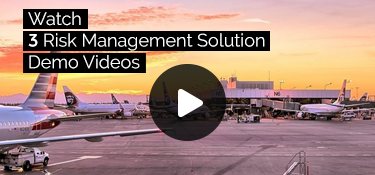What Is It Like to Lose Control of Your Aviation SMS

Losing control of your aviation SMS is largely a product of feeling overwhelmed by all the actions, documentation, and tasks required to implement and monitor safety.
While it is possible for safety culture to erode over time, to the point where the SMS does not perform well, losing control of an SMS often means not being able to “keep up” with things like:
- Safety assurance, such as managing safety issues, corrective actions, reviews, inspections, etc.;
- The workload necessary to complete SMS design;
- Safety promotion, such as writing newsletters, taking safety surveys, etc.; or
- Reviewing, planning, and implementing the SMS.
Often, the feeling of losing control of your SMS is a combination of multiple of these elements. For example, you may have no problem monitoring safety performance, but may not have enough resources or “know-how” to implement your SMS.
The best way to get back in control of managing and implementing your aviation safety management system is to:
- Acquire guidance on how to better manage/implement your SMS; and
- Understand your safety needs and acquire pertinent resources.
Here are specific ways to regain control of your aviation SMS.
Understand the Needs of Your Safety Program

When you lose control of your SMS, one of the best activities you can do is stop and take an analysis of what your safety needs are. This is an attempt to outline what elements of your SMS are outside of your control.
Understanding the needs of your safety program involves looking at how your ability and performance in areas of safety management like:
- SMS implementation progress;
- Issue management;
- Safety performance monitoring;
- Corrective action management;
- Documenting SMS design, such as risk controls, identified hazards, etc.;
- Reviewing management activities;
- Success of safety promotional activities; and
- Thoroughness of safety policy, including documented policies, procedures, checklists, processes, etc.
For each of these areas of safety management, you might ask:
- Do we know what our goals are for this area of SMS?
- Do we have a clear strategy/procedure for how we manage this – i.e., do we know how to accomplish these goals?
- Do we think that the required work is being accomplished in this area of the safety program?
- If yes, is there clear, documented evidence for the required work is being done?
In short, you need to assess if you know why you are facilitating that area of SMS, how you are facilitating it, whether or not how you are addressing it is satisfactory, and if so, do you have evidence to prove it? If your answer is “No,” or “I don’t know,” to any of these questions, you are identifying a safety need.
Related Articles on Aviation Safety Program
- First Steps Starting Aviation Safety Program for Beginners - SMS Resources
- How to Create an Org Chart for Aviation Safety Programs
- Important Ways to Formally Document Aviation Safety Programs
If You Don’t Have a Safety Manager, Get One
Many smaller companies don’t have a dedicated safety manager. An existing employee, such as a pilot or department head, may acquire some safety duties in addition to their existing duties.
But once your organization grows large enough, such as 60-80 or more employees, it makes sense to hire a dedicated safety manager. This is because one employee splitting time as a safety manager will not be able to dedicate the required time/work needed to:
- Manage the SMS;
- Monitor the SMS;
- Document the SMS; and
- Implement the SMS
An aviation safety manager is usually responsible for some or all of the following:
- Reviewing all reported safety issues;
- Analyzing and assessing reported issues;
- Creating or delegating corrective action management;
- Managing safety promotion activities;
- Managing the documentation of the SMS, such as hazards identified, risks identified, control measures, etc.; and
- Reviewing safety data and performance.
At 100 or more employees, you will definitely need a dedicated safety manager.
Hire Safety Assistant

If you already have an aviation safety program but still feel like the SMS is out of your control, you may need to hire additional manpower to manage the rote, manual aspects of your safety program.
In rote, manual work, such as data entry or safety record keeping can be extremely time-consuming. Hiring a safety assistant makes a lot of sense if this extra work is holding your safety manager from actually managing the SMS.
Hiring a safety assistant makes sense because:
- You can grow your safety team;
- An assistant is a low-cost employee; and
- Your safety managers get to spend time working on their areas of expertise rather than simply performing data entry/documentation.
Hiring an assistant for your safety manager may free your safety manager up to work on regaining control of the safety program.
Get Free Aviation Safety Tools for Guidance
As said, a very common reason that companies lose control of their safety program is that they lack guidance or strategy for how to manage the SMS. In other words, they feel that they lack guidance on what to do next.
Fortunately, many free aviation safety guidance tools will help you evaluate many areas of your SMS. Here are some free resources for SMS mission-critical aspects of your safety program:
- Safety policy checklists;
- Safety policy templates;
- Safety audit checklists;
- Safety culture quiz (as you take the quiz, make a note of questions where you indicate your culture is struggling);
- SMS quality quiz (as you take the quiz, make a note of questions where you know your SMS performance/tools are lacking);
- Airline KPIs; and
- SMS Implementation plan checklist.
For a full list of free resources and free safety tools, follow the link.
Acquire Aviation Safety Software
Aviation safety software provides a suite of tools whose goal is to optimize your ability to design your SMS and enhance performance monitoring/management ability.
Aviation safety software:
- Does the job of an assistant;
- Offers the built-in processes and templates that act as natural guidance;
- Automates a very significant amount of manual work;
- Provides aviation industry tried and tested performance monitoring tools; and
- Provides a roadmap and templates for thorough SMS design; and
- Has high value-to-cost ratio.
Last updated December 2024.





